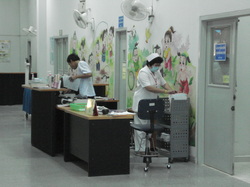SEARCH 012: Neurodevelopment and Imaging Among HIV-infected Children from the PREDICT Study

Overview
Two and a half million children are living with HIV/AIDS worldwide, accounting for 8% of the global HIV/AIDS epidemic. Treatment programs involving antiretroviral drugs lend hope that many of these children will enter adulthood, as is evidenced by the growing relevancy of Dr. Valcour's HIV Over 60 Cohort Study. However, less is known about the extent to which these children can grow and develop to enter the workforce and become productive members of society. A crucial determining factor may be the long-term cognitive consequences inflicted by the HIV virus during neurodevelopment. This, in turn, may be influenced by the timing of antiretroviral therapy (ART) initiation.
Although antiretroviral treatment is widely not offered to children over 12 months of age unless they meet WHO criteria for severe immunodeficiency (<15% CD4 count), this practice runs contrary to clinical trends seen in adults, where earlier antiretroviral intervention is though to be beneficial. The necessity to commit to ART treatment for life following its initiation also creates a new wrinkle; antiretroviral therapy is not without its fair share of side effects, and children entering adolescence frequently embody a rebellious nature. This is a truly perilous path to follow for a child who has begun ART procedures.
SEARCH 012 operates as a substudy under the longitudinal Pediatric Randomized Early versus Deferred Initiation in Cambodia and Thailand (PREDICT) study funded by the NIH's National Institute of Allergy and Infectious Diseases (NIAID) under the Division of Acquired Immunodeficiency Syndrome (DAIDS). The goal of PREDICT is to address the issue of ART timing in children by using a randomized study design, enrolling children from Thailand and Cambodia. SEARCH 012 aims to assess neurodevelopment by virtue of a multimodal imaging approach, utilizing Diffusion Tensor Imaging (DTI) and Tensor Brain Morphometry (TBM) analyses.
Significant effects of the virus and/or ART initiation can be assessed through comparisons between the 4 different arms of the study (HIV+ Immediate ART, HIV+ Deferred ART, HIV Neg - Exposed, and HIV Neg - Unexposed). The work will measure brain size, brain growth, and white matter integrity in children over a span of 3 to 4 years post-ART initiation. The project is currently nearing full enrollment, with several of the arms having already reached the 3 years post-ART initiation timepoint. We are excited to find out what the data has to tell us not only about the neurodevelopment of children with HIV, but also the effect that prolonged antiretroviral therapies have on the disease and central nervous system as a whole.
Two and a half million children are living with HIV/AIDS worldwide, accounting for 8% of the global HIV/AIDS epidemic. Treatment programs involving antiretroviral drugs lend hope that many of these children will enter adulthood, as is evidenced by the growing relevancy of Dr. Valcour's HIV Over 60 Cohort Study. However, less is known about the extent to which these children can grow and develop to enter the workforce and become productive members of society. A crucial determining factor may be the long-term cognitive consequences inflicted by the HIV virus during neurodevelopment. This, in turn, may be influenced by the timing of antiretroviral therapy (ART) initiation.
Although antiretroviral treatment is widely not offered to children over 12 months of age unless they meet WHO criteria for severe immunodeficiency (<15% CD4 count), this practice runs contrary to clinical trends seen in adults, where earlier antiretroviral intervention is though to be beneficial. The necessity to commit to ART treatment for life following its initiation also creates a new wrinkle; antiretroviral therapy is not without its fair share of side effects, and children entering adolescence frequently embody a rebellious nature. This is a truly perilous path to follow for a child who has begun ART procedures.
SEARCH 012 operates as a substudy under the longitudinal Pediatric Randomized Early versus Deferred Initiation in Cambodia and Thailand (PREDICT) study funded by the NIH's National Institute of Allergy and Infectious Diseases (NIAID) under the Division of Acquired Immunodeficiency Syndrome (DAIDS). The goal of PREDICT is to address the issue of ART timing in children by using a randomized study design, enrolling children from Thailand and Cambodia. SEARCH 012 aims to assess neurodevelopment by virtue of a multimodal imaging approach, utilizing Diffusion Tensor Imaging (DTI) and Tensor Brain Morphometry (TBM) analyses.
Significant effects of the virus and/or ART initiation can be assessed through comparisons between the 4 different arms of the study (HIV+ Immediate ART, HIV+ Deferred ART, HIV Neg - Exposed, and HIV Neg - Unexposed). The work will measure brain size, brain growth, and white matter integrity in children over a span of 3 to 4 years post-ART initiation. The project is currently nearing full enrollment, with several of the arms having already reached the 3 years post-ART initiation timepoint. We are excited to find out what the data has to tell us not only about the neurodevelopment of children with HIV, but also the effect that prolonged antiretroviral therapies have on the disease and central nervous system as a whole.
|
Collaborators
|
Study Publications
|
|
Sponsors
|
